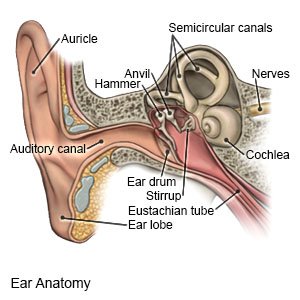Acoustic Neuroma Microsurgery
Medically reviewed by Drugs.com. Last updated on Aug 4, 2025.
Acoustic neuroma microsurgery is used to remove a tumor from nerves in your ear. The nerves help control your balance and hearing.
 |
WHILE YOU ARE HERE:
Before your surgery:
- Informed consent is a legal document that explains the tests, treatments, or procedures that you may need. Informed consent means you understand what will be done and can make decisions about what you want. You give your permission when you sign the consent form. You can have someone sign this form for you if you are not able to sign it. You have the right to understand your medical care in words you know. Before you sign the consent form, understand the risks and benefits of what will be done. Make sure all your questions are answered.
- General anesthesia will keep you asleep and free from pain during surgery. Anesthesia may be given through your IV. You may instead breathe it in through a mask or a tube placed down your throat. The tube may cause you to have a sore throat when you wake up.
- A heart monitor is also called an ECG or EKG. Sticky pads placed on your skin record your heart's electrical activity.
During your surgery:
- Your surgeon will make an incision behind or above your ear. He or she will make an opening in your skull. Part of your skull may be removed to help your surgeon see your inner ear. Bones of your inner ear and behind your ear may be removed. Monitoring will be done to decrease the risk for damage to your nerves and other areas of your brain. Your surgeon will then remove the tumor.
- If a piece of your skull bone was removed for surgery, it will be put back and secured. The surgery area will be closed with stitches.
Related medications
After your surgery:
- A tight bandage will be placed over your incision to prevent bleeding. The bandage will also help keep the area clean and dry to prevent infection. Your healthcare provider may remove the bandage shortly after surgery to check your incision.
- Stay in bed for the first day after surgery. On day 2 after your surgery, your healthcare providers may help you get out of bed to move around. A therapist may work with you on exercises to decrease dizziness and improve your balance.
- A lumbar drain may be needed after your surgery if you have a CSF leak. The drain will remove any leaking fluid from the area around your spinal cord.
- Medicines may be given to prevent or fight an infection or to relieve pain, swelling, or a fever.
- Within 1 week you may need an audiometry test and CT scan to check how you are doing.
RISKS:
Your brain, eyes, bones, blood vessels, or nerves may be injured during surgery. If a nerve is injured, you may need to have another surgery to repair it. You may have trouble moving your facial muscles or lose feeling in your face. You may have hearing loss, headaches, tinnitus, trouble seeing, or problems with balance. Cerebrospinal fluid (CSF) may leak out of your surgery site or from your nose. You may have a stroke or a blood clot in your leg or arm. If your tumor is not completely removed during surgery, it may grow back.
CARE AGREEMENT:
You have the right to help plan your care. Learn about your health condition and how it may be treated. Discuss treatment options with your healthcare providers to decide what care you want to receive. You always have the right to refuse treatment.© Copyright Merative 2025 Information is for End User's use only and may not be sold, redistributed or otherwise used for commercial purposes.
The above information is an educational aid only. It is not intended as medical advice for individual conditions or treatments. Talk to your doctor, nurse or pharmacist before following any medical regimen to see if it is safe and effective for you.
Further information
Always consult your healthcare provider to ensure the information displayed on this page applies to your personal circumstances.
